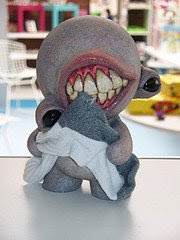As I was yet again emptying the lint from my dryer lint trap I started wondering what the lint is and were does it come from? Every load that I wash turns out a good amount of lint. When they go into the dryer the clothes have already been cleaned so I did not imagine it being from dirt. So I fired up Google, did some research, and came up with these top three reasons.
Invasive alien species
The first theory I ran across postulates that lint comes from a non-native invasive alien species. The lint could be their left over biomass (feces) or possibly even shed skin. While this answer is intriguing, it does seem a little far fetched and only raises more questions, like: Where did the aliens come from, why do they only target dryers, how come we have never seen them before? If you think about it though I could explain those missing socks. Perhaps the aliens primary food source is socks…
The Quantum Theory of Laundry
The Quantum Theory of Laundry ( QTL ) states that the dryer is a closed loop, where nothing can escape, therefore any missing socks must still be in the dryer. Furthermore, this theory goes against conventional wisdom and suggests that removing lint is actual not a good idea as it will prevent you from ever seeing your missing socks again. The QTL uses many big scary mathematical equations to show proofs that the socks take on a particular wave function during which they transform from a sock into lint. Leaving the lint in the lint trap on subsequent loads further explains how socks may randomly appear in a different load. This is due to the wave function hitting the lint in the trap and converting it back into a sock.
Cloth Fibers
By far the most sensical, and most boring, is the idea that lint is cloth fibers from the clothing. During all that tumbling in the washer and dryer the clothes get knocked around. This causes the fibers to break down and eventually fall away from the clothing. After they fall away from the clothing the fibers get jumbled around in the dryer until they eventually make their way to the exhaust vent, which pushed the air through the lint trap where the lint is caught.
With the cloth fibers theory it is very important to clean out the lint trap after every use of the dryer. This is because the lint is a very dry and flammable fabric. If too much builds up in the lint trap it has the potential to catch fire, burn up the dryer, burn down the house, and scare your kitten. It is not good to scare your kitten.
It should be noted that the other two theories also attempt to explain how socks disappear, while this idea completely ignores the situation. It does however explain why clothes get that “threadbare” look after many washes. Their fibers ( or threads ) are breaking apart.
I hope that helps you solve why it is in your own dryer that lint seems to magically appear after each load.
Resources
